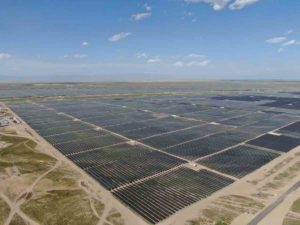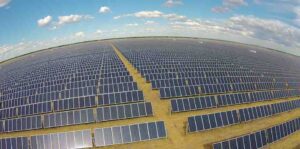Are we forsaking food crops for solar farms? Do PV panels leach toxic chemicals into soil and water? Will offshore wind kill hundreds of whales a year? Does wind turbine noise make people and animals sick?
Despite regularly being debunked, or having no basis in peer-reviewed reality in the first place, renewable energy myths just keep on keeping on, part of a global strategy to move from attacking climate science to attacking climate solutions. Not so much climate denial as technology denial.
In Australia, the arrival in Canberra of a government with a moderately ambitious plan to decarbonise the economy has reinvigorated the anti-renewables rumour machine. The prospect of an offshore wind industry has sent it into overdrive.
Such is the momentum that the first sitting day of federal Parliament in 2024 was marked by an organised anti-renewables rally attended by former National Party leader Barnaby Joyce and a long list of climate deniers, fossil boosters and nuclear pushers from both the LNP and other parties.
As RenewEconomy reported, the Rally Against Reckless Renewables was allegedly intended by organisers to address community concerns about the transition to renewables and the impact it is undoubtedly having on regional communities.
The reality, however, was a whole lot of unhinged anti-wind and solar vitriol and wild conspiracy theories, betraying the desperation of conservative politicians who are clinging for dear life to hopes that fear, uncertainty and doubt laced with wild promises of a nuclear power industry will bring renewable energy undone.
So what to do?
A new report out of Columbia Law School in the US has taken a methodical approach, identifying 33 of the most pervasive myths about solar, wind and electric vehicles and rebutting them using transparent, fact-based responses, “relying to the greatest extent possible on peer reviewed academic literature and government publications.”
As the report’s authors write, this is important to do because “misinformation” and coordinated “disinformation” are being used to undermine support for renewables, at a time when the global effort to stave off dangerous global warming has become more urgent than ever.
“False claims about renewable energy come in many varieties,” the report says. “Some claims rely on sheer bombast, seemingly designed to shock and inflame audiences, rather than contribute to informed debate on pressing policy choices.
“Some emphasize theoretical impacts of poorly-designed renewable energy projects while ignoring the many well-established methods to minimize or even eliminate those impacts. Some frame any departure from the status quo, such as the use of farmland for solar production, as categorically inconceivable.
“Some rely on unsubstantiated theories of causation, such as speculation that whale deaths stem from noise related to wind farm surveys…
“Some drill down with single-minded focus on the toxicity or carbon footprint of renewable energy infrastructure or its component parts, while declining to acknowledge that fossil fuel extraction, production, and distribution cause far greater environmental contamination, harm to human health, and climate instability.”
Reassuringly, or maybe alarmingly, the Columbia researchers’ list of the 33 most enduring false claims about wind, solar and EVs in the US is easily transferable to Australia. They even refer to Australian research to help debunk False Claim #17: Low-frequency noise from wind turbines harms human health and causes “wind turbine syndrome.”
Here’s a look at just a few of the top myths used against solar and wind – and how the researchers from Columbia’s Sabin Center for Climate Change Law respond to them.
False Claim #2: Toxic heavy metals, such as lead and cadmium, leach out from solar panels and pose a threat to human health
This has been a popular myth in Australia, lately, as concern about solar farm development morphs into a battle pitting agriculture against renewables.
Last year, a Queensland’s farmer’s claim to 2GB radio that a solar farm proposed near his property would send “contaminated run-off straight into the Great Barrier Reef” was reported without question by the Murdoch media.
According to research cited by the Columbia team, all materials in a solar panels are “insoluble and non-volatile at ambient conditions,” and “don’t mix with water or vaporize into air.” Moreover, they are encased in tempered glass that not only withstands high temperatures, but is also strong enough to pass hail tests and is regularly installed in Arctic and Antarctic conditions.
The report says that while it is “theoretically possible that, when exposed to extremely high heat exceeding that of a typical residential fire, panels “could emit vapors and particulates from PV panel components to the air,” these risks are limited.
“When a cadmium telluride panel is exposed to fire of an intensity sufficient to melt the glass on the panel, for example, “over 99.9% of the cadmium [is encapsulated in] the molten glass.”
Furthermore, it says, even in the worst-case scenarios of earthquakes, fires, and floods, it is unlikely that cadmium concentrations in air or sea water would exceed the environmental regulation values.
Meanwhile, one peer-reviewed study in the Journal of Natural Resources and Development found that fly ash, a product of coal combustion “commonly disposed of in landfills and as a soil amendment in agriculture,” contains significantly higher concentrations of lead (40x), cadmium (1.1x) and selenium (4x) than the soil samples taken directly underneath solar panels in a study area.
False Claim #6: Solar projects harm biodiversity
This is another popular line of argument that crops up against solar farm proposals in Australia – a part of the broader “renewables are bad for the environment” theme some politicians, in particular, are really embracing.
Renewables detractors like to argue that wind and solar farms are actually ecological vandals dressed in green clothing – and that they get away with this crime by somehow skirting development regulations.
But as this One Step Off The Grid story illustrates, this is not the case in reality – particularly with the increase in community concerns, both real and hyped, being lodged with councils and planning authorities.
Rather, say the Columbia researchers, “when properly developed, including by incorporating pollinator habitat in project design, large -scale solar farms can sustain and even increase natural biodiversity.
“Microclimates within solar farms can enhance botanical diversity, which, in turn can enhance the diversity of the site’s invertebrate and bird populations. In addition, the shade under solar panels can offer critical habitat for a wide range of species, including endangered species.
“Shady patches likewise prevent soil moisture loss, boosting plant growth and diversity, particularly in areas impacted by climate extremes.”
False Claim #19: Wind turbines are a major threat to birds, bats, and other wildlife
In answer to this myth, the researchers point out that by far the biggest threat to wildlife – and particularly endangered species – is climate change, and the increased incidence of extreme weather and disaster events that is already coming with it.
They also note that, comparatively speaking, wind power is a relatively minor source of mortality for birds.
“The US Fish and Wildlife Service has estimated that, throughout the United States, cats kill an average of 2.4 billion birds per year, and collisions with building glass kill an average of 599 million birds, while wind turbines kill an average of 234,000 birds per year.
Comparing apples with apples, however, the study also shows that “wind power causes far fewer bird deaths than fossil fuels per unit of energy output, a metric that is not sensitive to the total number of wind turbines installed.
“While fossil fuels cause 5.2 avian fatalities per GWh, wind turbines cause only 0.3–0.4 avian fatalities per GWh.”
In addition, the study goes on to say, actionable steps can be taken to reduce bird and bat fatalities from wind turbines. These include painting turbine towers or blades and AI technology to alter wind turbine speeds when birds approach – as is being trialed at this Tasmanian wind farm.
“The relatively simple action of painting the tower black has been shown to reduce deaths by roughly 48%, while painting one of the blades black has reduced deaths by 70%,” the report says.
False Claim #22: Wind turbines will generate an unsustainable amount of waste
Another favourite of the anti-wind camp in Australia, this myth recently got a good airing on mainstream media via the sensational discovery of a wind turbine blade graveyard in a Queensland forest. Except it wasn’t.
As RenewEconomy reported, the “forest” was actually the private property of local Ravenshoe business Kidner Contracting, and the turbine blades – from Queensland’s first ever wind farm, the 12MW Wind Hill project – were not so much dumped as stored there, instead of being sent to the tip.
“We have taken possession of disused wind turbine blades from the Windy Hill Wind Farm and are storing them on our 280 acre free hold quarry which take up around 500m2,” said Kidner Contracting managing director Blake Kidner in a statement forwarded to RenewEconomy.
“We see future value in the blades in a circular economy. These blades were destined for landfill, but we took possession of them and were stockpiled onsite as we have been working on ideas for reuse of them.”
Indeed, as the Columbia report notes, roughly 80%-85% of modern wind turbine materials, including the steel turbine tower, can be recycled. The blades, which which contain fiberglass composite materials, are a work in progress, with new techniques being explored and trialled.
Meanwhile, the researchers say it’s once again worth comparing apples with applies.
“One company’s analysis found that total cumulative waste from decommissioned turbines blades could exceed 14 million tons by the early 2040s. This is not insignificant. However, Nature Physics has projected that fossil fuel-based power generation is expected to produce roughly 45,550 million metric tons of coal ash alone by 2050, along with 249 million metric tons of oily sludge.
“These figures far exceed the anticipated waste from wind turbine blades, and both coal ash and oily sludge are known to be toxic. For context, roughly 600 million tons of construction and demolition debris were generated in the United States in 2018 across all sectors.”










